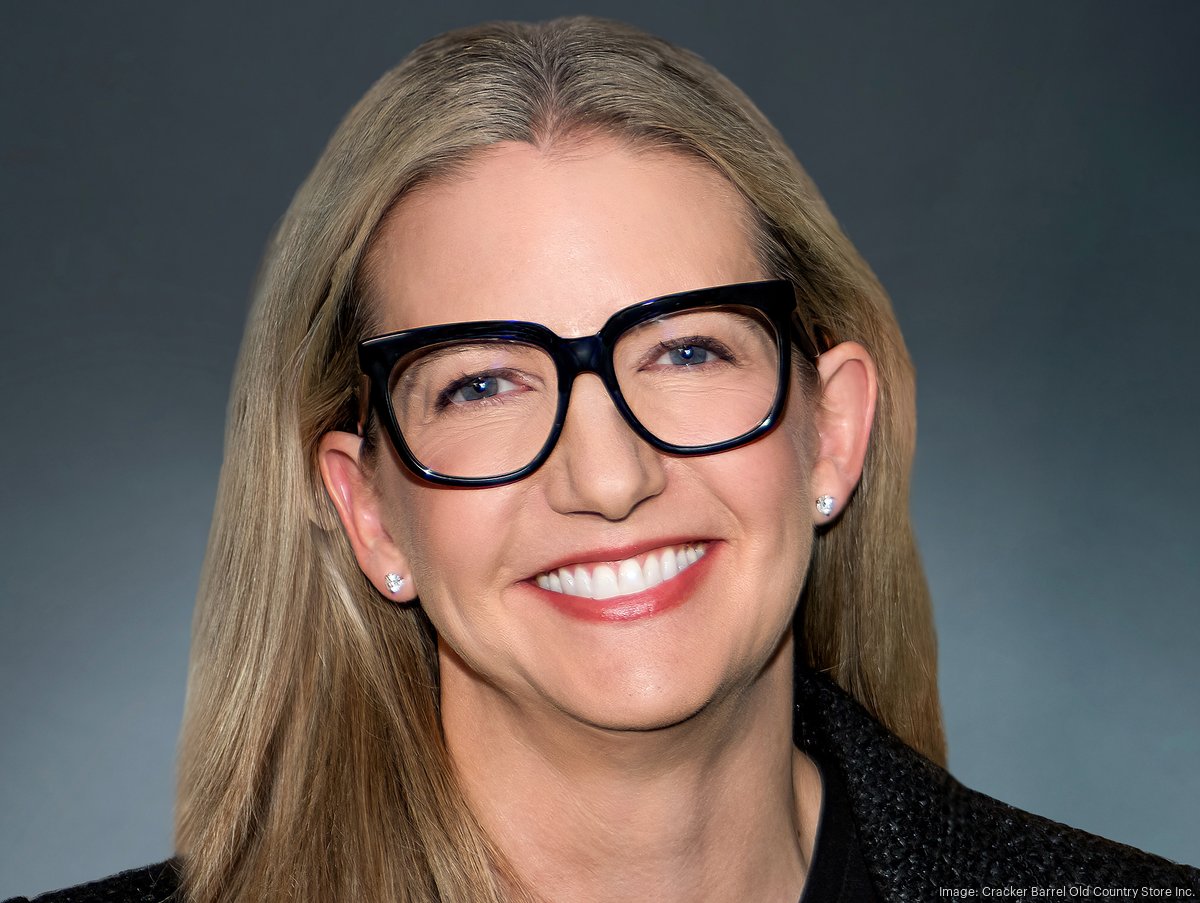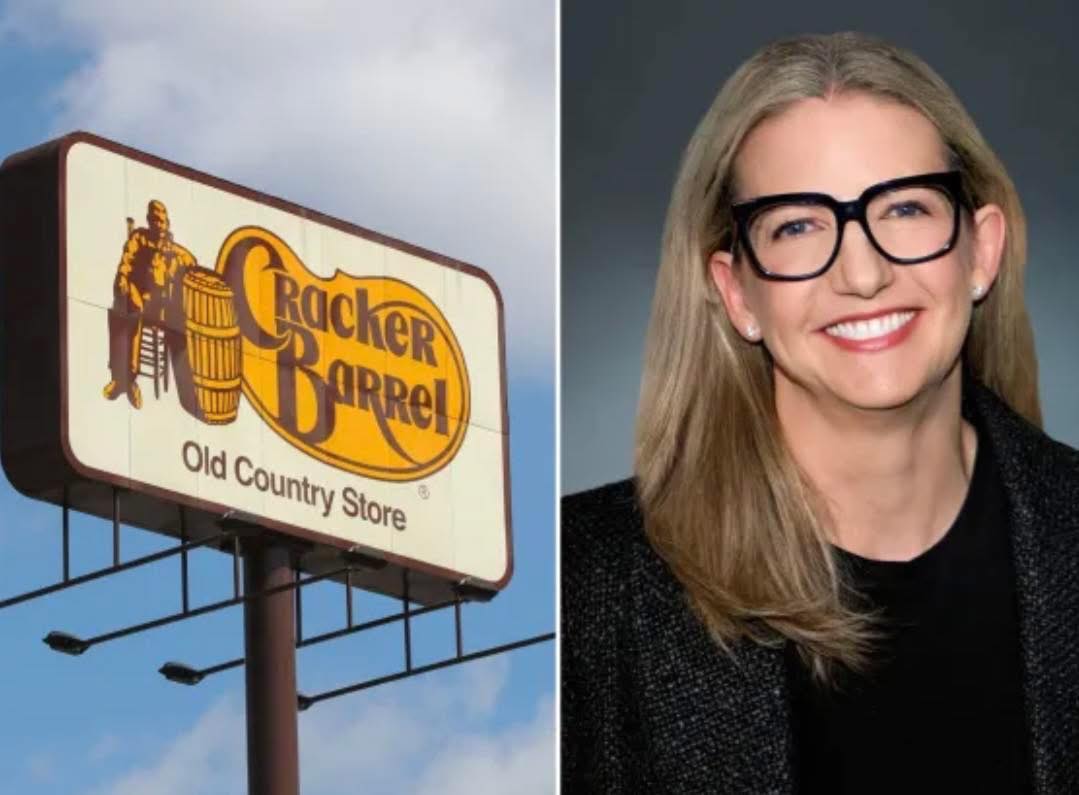A New Era of Leadership and a Risky First Move
When Julie Felss Masino assumed the role of Cracker Barrel’s CEO, she inherited more than just a restaurant chain; she inherited a cultural institution. Known for rocking chairs on porches, fireplaces with checkerboards, and a heavy dose of Southern nostalgia, Cracker Barrel has long represented a particular slice of Americana.

Masino wasted little time in signaling change. Her decision to remove the image of the “nice old white guy” from the company’s logo was bold, symbolic, and controversial. The move was intended to modernize the brand’s image, making it appear less white, less Southern, and less tied to cultural tropes that many critics have called outdated or exclusionary.
Yet the reaction was swift and unforgiving. Since she took over, Cracker Barrel’s stock value has fallen by 34%, representing a $250 million loss. For many, this decline illustrates the danger of tampering with brand identity too quickly.
The Power and Burden of Nostalgia in Cracker Barrel’s DNA

For decades, Cracker Barrel thrived on an identity that leaned heavily into Southern tradition. Guests didn’t just come for chicken and dumplings or biscuits and gravy; they came for the “experience.”
-
The décor: walls lined with antique farm tools, portraits, and advertising signs.
-
The music: bluegrass and country tunes playing softly in the background.
-
The imagery: a welcoming white-bearded gentleman in the logo, evoking a kind of grandfatherly figure.
To millions of loyal customers, this imagery wasn’t just marketing—it was personal. It reminded them of road trips, family breakfasts, and a simpler way of life. But nostalgia is double-edged. For others, the branding carried uncomfortable undertones of exclusion, rooted in a version of the South that felt far from inclusive.
Masino’s decision to drop the logo figure was a clear attempt to address those concerns. But in doing so, she risked erasing the emotional anchor that bound older customers to the brand.
A $250 Million Stock Plunge: What Went Wrong?

The market’s reaction to Masino’s changes was brutal. A 34% decline in stock value—roughly $250 million in lost company worth—is not the result of a single design tweak. It reflects deeper anxieties.
Investor Skepticism
Wall Street tends to reward stability and predictability. When a company abruptly changes its visual identity, investors worry about alienating the customer base without a clear roadmap to replace lost revenue.
Consumer Backlash
On social media, reactions ranged from confusion to outrage. Loyal customers posted comparisons of the old and new logos, accusing the company of “erasing tradition.” Hashtags like #NotMyCrackerBarrel trended among some groups, amplifying the sense of betrayal.
Sales Performance Concerns
Behind the headlines, same-store sales performance may have already been under strain. When symbolic rebrands happen during tough times, investors often see them as a distraction rather than a solution.
The result: panic selling, falling stock prices, and growing doubts about Masino’s leadership.
Tradition Versus Transformation: A Cultural Battle

Masino’s gamble reflects a broader cultural and corporate dilemma: should legacy brands cling tightly to their past or reinvent themselves for a changing society?
-
The traditionalist argument: Cracker Barrel’s Southern charm is its lifeblood. Remove the imagery, and you remove the emotional essence that makes the chain unique.
-
The progressive argument: The old branding alienates younger, diverse customers. To survive the next generation, the company must evolve into something more inclusive.
This isn’t just about fried chicken and rocking chairs. It’s about the identity of a company in a country where cultural debates shape consumer spending habits.
Lessons From Other Rebranding Efforts
Cracker Barrel isn’t the first company to risk its identity for modernization—and it won’t be the last.
-
Aunt Jemima → Pearl Milling Company
In 2021, PepsiCo retired the Aunt Jemima brand due to its racial stereotypes. While some loyalists resisted, the company avoided long-term financial damage by pairing the rebrand with clear communication and investment in inclusive marketing. -
Tropicana’s Packaging Disaster
In 2009, Tropicana redesigned its orange juice cartons, replacing the iconic orange-with-straw logo. Sales plummeted 20% in two months, costing the brand $30 million, before they reverted back. Lesson: don’t alienate customers without a bridge. -
Domino’s Pizza Reinvention
Domino’s famously admitted its pizza “wasn’t good” and relaunched with a new recipe and marketing campaign. The transformation succeeded because it was authentic, customer-driven, and paired with operational changes—not just cosmetic branding.
Cracker Barrel’s rebrand could land in any of these categories. Success depends on whether Masino can connect cosmetic changes to deeper operational and cultural evolution.
Why a Logo Alone Isn’t Enough

A logo is a symbol, not a strategy. Masino’s risk is that by changing the imagery without fully reworking the brand experience, the move feels hollow.
To resonate, Cracker Barrel needs a multi-layered rebrand strategy:
1. Menu Innovation
Offering a few dishes inspired by diverse cuisines—while keeping classics—could broaden appeal without alienating regulars. Imagine chicken and waffles alongside tamales or collard greens next to Mediterranean-style salads.
2. Inclusive Marketing Campaigns
Advertisements showcasing diverse families enjoying meals together would help reposition the brand as welcoming to everyone.
3. Customer Experience Reboot
Staff training in inclusivity and hospitality ensures that the “feel” of the restaurant matches the new imagery. If the culture inside restaurants stays the same, the logo change loses credibility.
4. Gradual Evolution
Instead of shocking customers with sudden changes, brands often benefit from a phased rollout. A slow transition from the old mascot to broader, more inclusive imagery might have softened resistance.
How Masino Can Regain Control
While the $250 million loss looks daunting, recovery is possible. Here’s how:
Listening to Customers
Conducting focus groups, online surveys, and in-restaurant discussions could reveal how customers interpret the changes—and what balance they want between tradition and modernity.
Investor Transparency
Investors want reassurance that changes are tied to growth strategies, not just cultural statements. Quarterly updates on new customer acquisition, demographics, and same-store sales will help rebuild trust.
Building a Narrative
Masino could take to major media outlets to frame the story differently—not as “erasing tradition” but as “evolving tradition.” By sharing her vision openly, she could reshape public sentiment.
Blending Heritage With Progress
Instead of fully abandoning Southern imagery, Cracker Barrel might highlight the universal values behind it: family, hospitality, and comfort. Those values transcend demographics and could be reframed as American rather than Southern-only.
The Stakes for Cracker Barrel’s Future
This moment represents more than a quarterly financial dip—it’s a defining crossroads for the company. Will it remain a nostalgia-driven brand serving mostly older, traditional customers? Or will it reimagine itself as a modern chain welcoming all?
If Masino fails, Cracker Barrel risks becoming a cautionary tale, remembered for losing its soul in an attempt to “fix” what many didn’t believe was broken. But if she succeeds, the company could tap into younger, more diverse generations, ensuring its survival in an era where inclusivity matters more than ever.
Conclusion: Visionary Pivot or Branding Misstep?
Julie Felss Masino’s decision to remove the nostalgic “old white guy” from Cracker Barrel’s logo is more than a design choice—it’s a cultural statement. The backlash has cost the company dearly, with a 34% drop in stock and $250 million erased from its value.
Yet, the story isn’t finished. With thoughtful strategy, transparent communication, and authentic changes beyond the logo, Masino could still turn the tide. The challenge lies in striking a balance: keeping enough of Cracker Barrel’s heritage to comfort loyalists, while infusing enough modernity to attract new audiences.
In the end, this is not just about biscuits, fireplaces, or logos. It’s about how America’s legacy brands can navigate a cultural landscape that demands inclusivity while still cherishing tradition. Cracker Barrel’s future—whether it thrives or falters—will serve as a powerful case study in that balancing act.
